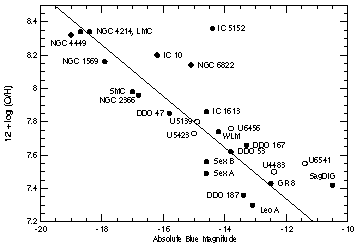


4.2. The Metallicity-Luminosity Relationship
Since the nebular abundance studies of the Magellanic Clouds in the mid 1970's (e.g., Peimbert & Torres-Peimbert 1974, 1976), it has been suggested that there might be a correlation between galaxian mass and the metallicity of the interstellar medium. Surveys of the abundances in a number of H II regions in irregular galaxies by Lequeux et al. (1979), Talent (1980), and Kinman & Davidson (1981) all produced a clear correlation of oxygen abundance with both galaxy mass and luminosity.
My collaborators and I have been using this relationship to find very low metallicity objects for the study of relative abundances (Skillman et al. 1988a, 1989a, b, 1994, 1997). Figure 7 is a plot of oxygen abundance versus luminosity for a collection of nearby dwarf irregular galaxies. Under the assumption of comparable mass/light (M/L) ratios, the correlation between metallicity and luminosity would also produce a mass - metallicity relationship. Dwarf galaxies from the M81 group (Miller & Hodge 1996) and the Sculptor group (Miller 1996) have also been found to lie on this relationship. Here I have plotted oxygen abundance versus luminosity instead of versus mass because luminosities are generally available, but reliable masses are more difficult to obtain. For those galaxies with reliable mass estimates, a correlation is also found between abundance and mass.
Not all dwarf galaxies comply with the metallicity - luminosity relationship shown in Figure 7. For example, many blue compact dwarf galaxies (BCDGs), which derive a significant fraction of their total luminosity from their high surface brightness, active star forming regions, lie to the left in Figure 7 (e.g., Roennback & Bergvall 1995). If the underlying correlation is between mass and metallicity, then this would be expected since the BCDGs are likely to have lower M/L ratios. While the correlation in Figure 7 is clear, it is also clear that there is significant scatter at any given absolute magnitude. The uncertainty in the oxygen abundance is usually less than 0.1 dex, and distance uncertainties may produce uncertainties in the luminosity as large as a magnitude (or, in the case of IC 5152, larger). Richer & McCall (1995) defined a subset of galaxies with accurate distances and abundances and found essentially the identical relationship. They also found that the scatter was smaller for the higher luminosity galaxies and larger for the lower luminosity galaxies (as would be expected if the scatter is mainly due to luminosity variations from different levels of recent star formation). Given a reasonable scatter in the M/L ratios, a tighter correlation between mass and metallicity may underlie the relationship in Figure 7.

|
Figure 7. Oxygen abundance plotted versus galaxy luminosity for dwarf irregular galaxies (from Skillman, Kennicutt, and Hodge 1989). New observations of dwarf galaxies in the M81 group have been added as open circles. |
On the other hand, the fundamental relationship may not be between mass and metallicity, but between surface density and metallicity. Mould, Kristian, & DaCosta (1983) first discovered that dwarf elliptical galaxies also show a strong correlation between metallicity and luminosity, and Aaronson (1986) showed that the metallicity vs. luminosity relationships for the two classes of galaxies are roughly identical in both slope and zero-point. Since low luminosity, high surface brightness, and relatively metal rich dwarf ellipticals have been observed, Bothun & Mould (1988) have suggested that surface density may be the fundamental parameter determining metallicity (see also Edmunds & Phillips 1989). The same may hold true for the dwarf irregulars, and is worth investigating observationally. To date, Van Zee (1996) has found that her sample of low surface brightness dwarf galaxies obey the same metallicity - luminosity relationship, and note the result described by Gary DaCosta in his lecture on the dwarf galaxy F8D1 in the M81 group.
Additional measurements of dynamical masses and mass surface densities will hopefully clarify the situation. In my opinion, there is a shortage of reliable mass estimates for dwarf irregulars. What we really want for this type of work are synthesis HI observations which provide a gas distribution and a rotation curve, from which it is possible to derive the mass distribution. Unlike the case for most spiral galaxies, a single dish line profile cannot be converted into a reliable total mass estimate because estimates of the appropriate inclination and radius from optical images can be specious. Since reliable mass estimates must be based on the more time consuming interferometric observations, results are lagging behind abundance measurements, but there is progress (e.g., Côté 1995).